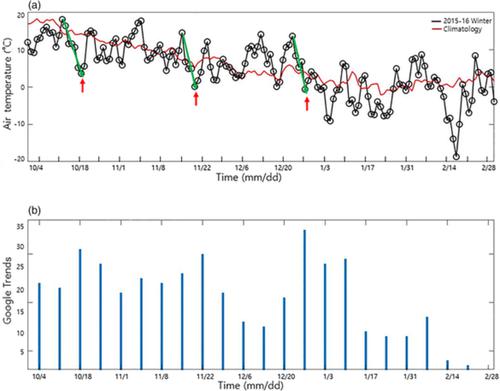当前位置:
X-MOL 学术
›
Meteorol. Appl.
›
论文详情
Our official English website, www.x-mol.net, welcomes your
feedback! (Note: you will need to create a separate account there.)
The effect of anomalous weather on the seasonal clothing market in New York
Meteorological Applications ( IF 2.3 ) Pub Date : 2021-03-12 , DOI: 10.1002/met.1982 Jungmi Oh 1 , Young‐Heon Jo 2, 3 , Kyung‐Ja Ha 1, 3
Meteorological Applications ( IF 2.3 ) Pub Date : 2021-03-12 , DOI: 10.1002/met.1982 Jungmi Oh 1 , Young‐Heon Jo 2, 3 , Kyung‐Ja Ha 1, 3
Affiliation

|
The occurrences of losing the merchandising calendar for seasonal clothes have become more frequent due to anomalous weather changes. In order to develop accurate sales forecasts for clothing retailers, weather changes should be incorporated. The purpose of the study was to find the timing of consumers' seasonal clothing demands and the relationship between the timing of consumers' searches for seasonal clothes and temperature changes. Specifically, drawing upon the United States' seasonal clothing demand from winter jacket Google Trends (GT) and air temperature data from empirical evidence, the study provided a methodology to discover the time lag for seasonal clothing demand timing based on temperature changes. Using the past five years (2014–2019) of GT and temperature data for the US state of New York, abnormal weather due to a significant El Niño year (2015–2016) and a weak La Niña year (2017–2018) was analysed. It suggested that consumers' search activities start when the temperature decreased rapidly continuously for at least six days. Furthermore, a plausible index was employed to determine the timing of peak demand with cumulative sums (CUSUMs). Based on the CUSUMs of air temperature for 18 days, consumers started to search for winter jackets at about 118–128 CUSUMs for a La Niña year, 217–248 CUSUMs for an El Niño year and 281 CUSUMs for a normal year. The results give a guideline to meet consumers' seasonal needs in a timely manner.
中文翻译:

天气异常对纽约季节性服装市场的影响
由于天气变化异常,丢失季节性服装商品销售日历的情况变得更加频繁。为了为服装零售商制定准确的销售预测,应考虑天气变化。该研究的目的是找到消费者对季节性服装需求的时间以及消费者寻找季节性服装的时间与温度变化之间的关系。具体而言,该研究利用了来自冬季外套Google趋势(GT)的美国季节性服装需求以及来自经验证据的气温数据,该研究提供了一种方法,可以根据温度变化来发现季节性服装需求时机的时滞。使用过去五年(2014-2019年)的美国纽约州GT和温度数据,分析了厄尔尼诺现象严重的年份(2015-2016)和拉尼娜脆弱的年份(2017-2018)导致的异常天气。这表明,当温度连续至少连续六天迅速下降时,便开始了消费者的搜索活动。此外,采用合理的指标来确定具有累计总和(CUSUM)的高峰需求的时间。根据18天的CUSUM气温,消费者开始在LaNiña年以118-128 CUSUM,在ElNiño年以217-248 CUSUM和在正常年份以281 CUSUM搜寻冬季夹克。结果为及时满足消费者的季节性需求提供了指导。当温度连续至少连续六天迅速下降时,便开始搜索活动。此外,采用合理的指标来确定具有累计总和(CUSUM)的高峰需求的时间。根据18天的CUSUM气温,消费者开始在LaNiña年以118-128 CUSUM,在ElNiño年以217-248 CUSUM和在正常年份以281 CUSUM搜寻冬季夹克。结果为及时满足消费者的季节性需求提供了指导。当温度连续至少连续六天迅速下降时,便开始搜索活动。此外,采用合理的指标来确定具有累计总和(CUSUM)的高峰需求的时间。根据18天的CUSUM气温,消费者开始在LaNiña年以118-128 CUSUM,在ElNiño年以217-248 CUSUM和在正常年份以281 CUSUM搜寻冬季夹克。结果为及时满足消费者的季节性需求提供了指导。
更新日期:2021-03-12
中文翻译:

天气异常对纽约季节性服装市场的影响
由于天气变化异常,丢失季节性服装商品销售日历的情况变得更加频繁。为了为服装零售商制定准确的销售预测,应考虑天气变化。该研究的目的是找到消费者对季节性服装需求的时间以及消费者寻找季节性服装的时间与温度变化之间的关系。具体而言,该研究利用了来自冬季外套Google趋势(GT)的美国季节性服装需求以及来自经验证据的气温数据,该研究提供了一种方法,可以根据温度变化来发现季节性服装需求时机的时滞。使用过去五年(2014-2019年)的美国纽约州GT和温度数据,分析了厄尔尼诺现象严重的年份(2015-2016)和拉尼娜脆弱的年份(2017-2018)导致的异常天气。这表明,当温度连续至少连续六天迅速下降时,便开始了消费者的搜索活动。此外,采用合理的指标来确定具有累计总和(CUSUM)的高峰需求的时间。根据18天的CUSUM气温,消费者开始在LaNiña年以118-128 CUSUM,在ElNiño年以217-248 CUSUM和在正常年份以281 CUSUM搜寻冬季夹克。结果为及时满足消费者的季节性需求提供了指导。当温度连续至少连续六天迅速下降时,便开始搜索活动。此外,采用合理的指标来确定具有累计总和(CUSUM)的高峰需求的时间。根据18天的CUSUM气温,消费者开始在LaNiña年以118-128 CUSUM,在ElNiño年以217-248 CUSUM和在正常年份以281 CUSUM搜寻冬季夹克。结果为及时满足消费者的季节性需求提供了指导。当温度连续至少连续六天迅速下降时,便开始搜索活动。此外,采用合理的指标来确定具有累计总和(CUSUM)的高峰需求的时间。根据18天的CUSUM气温,消费者开始在LaNiña年以118-128 CUSUM,在ElNiño年以217-248 CUSUM和在正常年份以281 CUSUM搜寻冬季夹克。结果为及时满足消费者的季节性需求提供了指导。











































 京公网安备 11010802027423号
京公网安备 11010802027423号